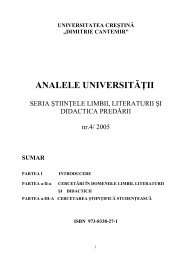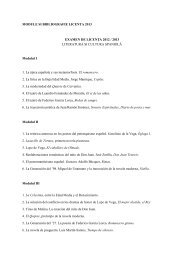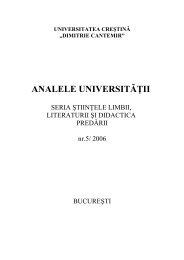analele universităţii - Facultatea de Limbi Straine - Dimitrie Cantemir
analele universităţii - Facultatea de Limbi Straine - Dimitrie Cantemir
analele universităţii - Facultatea de Limbi Straine - Dimitrie Cantemir
Create successful ePaper yourself
Turn your PDF publications into a flip-book with our unique Google optimized e-Paper software.
problems in the lives of stu<strong>de</strong>nts, and targeted professional help for those<br />
in need." 7<br />
Finnish schools are generally small (fewer than 300 pupils) with<br />
relatively small class sizes (around 20 stu<strong>de</strong>nts), and are uniformly well<br />
equipped. The notion of caring for stu<strong>de</strong>nts educationally and<br />
personally is a central principle of their school policy. All stu<strong>de</strong>nts<br />
receive, as I have mentioned before, a free meal daily, as well as free health<br />
care, transportation, learning materials, and counselling in their schools,<br />
so that the foundations for learning are in place. Beyond that, access to<br />
quality curriculum and teachers has become a central aspect of Finnish<br />
educational policy.<br />
Between ages 7-14 years, a Finnish child spends around 5400 hours in<br />
school. Within the same age period, a French child spends around 8300<br />
hours in school. So, “less is more” at this point and quality does prevail<br />
over quantity.<br />
Finland has been doing what Romania has not and apparently, in this<br />
context, cannot or is not willing to. Over the past 40-50 years, Finland has<br />
moved focus from a highly centralized system emphasizing external testing<br />
to a more localized system in which highly trained teachers <strong>de</strong>sign<br />
curriculum around the very flexible national standards that are used as<br />
gui<strong>de</strong>lines to follow. The logic of the system is to invest in the capacity of<br />
local schools and teachers’ lea<strong>de</strong>rship to meet the needs of all stu<strong>de</strong>nts.<br />
We resume a few of the principles of the Finnish Reform:<br />
Finland changed paradigm: from a closed paradigm based on<br />
“either/or” polarities, on fixed dismembered things, they moved to a live<br />
organic one that synthesizes, relates, organizes, contains “both/and”<br />
polarities.<br />
Finns <strong>de</strong>ci<strong>de</strong>d to invest in education to change course.<br />
They provi<strong>de</strong>d social support for stu<strong>de</strong>nts including a free<br />
daily meal, free health and <strong>de</strong>ntal care, transportation, learning materials,<br />
and counselling in schools.<br />
They upgra<strong>de</strong>d the teaching profession and trained better<br />
teachers. All teachers have a Master’s <strong>de</strong>gree.<br />
7 Sahlberg, Pasi, Educational Change in Finland, in A. Hargreaves, M. Fullan, A.<br />
Lieberman, and D. Hopkins (Eds.), Second International Handbook of Educational<br />
Change, Springer, New York, 2009, page 7.<br />
40







